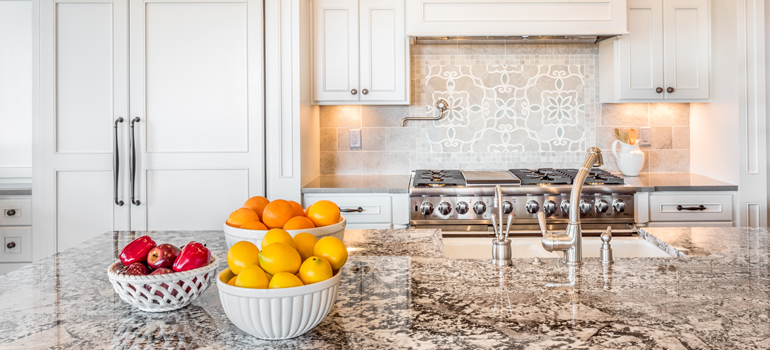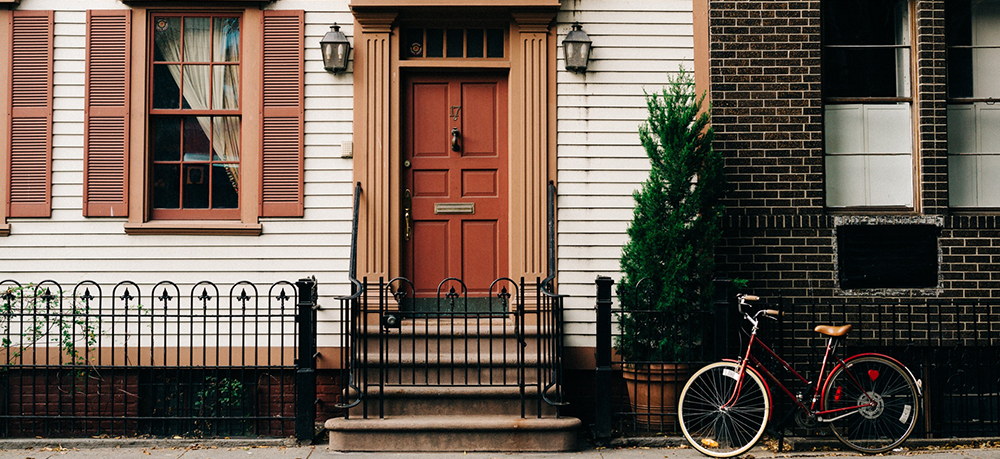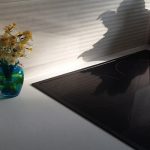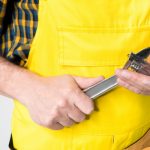
Burglary is a nightmare scenario for every householder and it’s reasonable to be concerned. There’s not only the cost of potentially stolen items, but there’s also the expense of repairing damage to the property and time lost from work while dealing with the incident. On top of all the practical issues, the emotional costs of experiencing a home invasion are incalculable.
It’s always important to secure your home, but some types of housing are more vulnerable than others. So in this guide, we’ll explain how to effectively secure your home to prevent a burglary. Let’s dive in.
Table of Contents
Burglar-proof the front door
Security advice can seem very complex at times, so let’s start with the basics. When you’re planning home protection in the UK, it doesn’t get much more basic than having a burglar-proof front door.
You should make sure your house is well-equipped with a professional door entry installation and security system. To prevent a theft and save your doors, here are a few starting pointers:
- High-quality British standard 3621 door locks are essential – Many insurance companies specify that, as a minimum, a BS3621 five-lever mortice lock must be fitted to all external doors. It’s easy to tell if you have a lock that meets this standard – just look for the kitemark, which will be engraved or stamped on the lock.
- Flats or properties with only one exit require a slightly different lock, one that meets British standard 8621 – Like the BS3621, these are tested against standard burglary techniques, such as drilling. Unlike a BS3621 lock, a BS8621 can be opened from the inside without a key. In terms of fire safety, the importance of being able to exit the property without a key can’t be overstated.
- Use anti-snap locks – If you have doors secured by Euro cylinder locks, it’s important that they meet certain standards. We’ll talk more about this below, or you can learn about lock snapping and how to prevent it here.
- Use Secured by Design door furniture – Secured by Design is a UK police initiative promoting products that help reduce crime. Products with Secured by Design accreditation have gone through a vigorous series of tests that show they meet high standards.
- Install a nightlatch – Nightlatches are suitable for inward opening timber doors and are best used in conjunction with another lock, such as a deadlock or Euro cylinder. If you’re installing a new nightlatch, make sure it conforms to British standards.
- Install letterbox protection – Letterboxes should be fitted at least 40cm from the door lock, and valuables and keys shouldn’t be within sight of it; an internal cover plate offers extra protection.
- Upgrade your strike plate – This is the metal rectangle on the inside of the door into which the deadbolt or door latch is inserted. If the strike place is loose or worn, it needs replacing.
- Make sure the hinges of entry doors are on the inside of the house – If they’re not, a burglar can ignore the lock and simply pop the hinges to gain entry.
- Ensure the door frames and doors are solid – External doors should be at least 4.4cm thick, hung with 10cm hinges and fit securely in their frames. Steel doors are not only durable but can also work as a burglar deterrent. Also, it’s best if there are no glass elements, as glass is a lot easier to break than wood or steel.
- Use a key safe to store spare keys for your home, rather than hiding them around the front door – The lock could meet all standards possible, but if an intruder manages to get hold of a key, it offers no protection at all.
- Use an Anti-Kick device for wooden doors. – If you have a wooden front door, an anti-kick device will not only save your home but will reduce the need for a door repairman in case you do become a victim of a burglary attempt.
Check also:
Beginner’s Guide to Door Lock Parts
Install front door security devices for extra protection
Some house security tips are devised with specific situations in mind. Extra security devices for front doors can be especially valuable to elderly people who are rightly cautious about opening the door to strangers and can guard against burglars who pretend to be ‘just passing’.
- Video doorbells – A digital doorviewer allows you to see who is at the door without opening it. Add a video/audio intercom and you can talk to the person on the other side of the door from the comfort of your armchair. And if you don’t like what they have to say, you don’t have to let them in.
- Smart locks – If you’ve ever returned home just to check if you locked the front door, this is for you. A smart lock can be operated remotely through an app on your phone.
Read also:
13 Tips for Improving a Conservatory’s Security
Secure other vulnerable doors in the house
Once the front door is secure, it’s important to take care of the rest of the high-risk doors. uPVC doors on patios or conservatories along with garage doors could be more vulnerable and, therefore, could be targeted by burglars. This is how you can protect them.
How to secure uPVC doors
- Make sure you have an anti-snap lock – Euro cylinder locks must meet one of two standards. These are SS312 Diamond and TS007 3 Star. You’ll find the standards stamped on the lock below the keyhole.
- Check your door handle – A high-security handle makes a great extra line of security. Look for a handle that conforms to security standards, such as TS007 2 Star, or is marked as Police Approved. If the handle is floppy, you should fix it as soon as possible.
- Sash jammers – Professionally installed sash jammers prevent the door from opening if the lock is broken. They’re available in both locking and non-locking versions.
- Fit hinge bolts – These are also known as dog bolts. They can be fitted to any outward opening door and improve security by preventing a closed door from being forced off its hinges.
- Install a door chain – A door chain adds an extra layer of security, slowing an intruder down. It also allows you to check who is at the door before deciding if you want to open it. Choose a chain with Secured by Design accreditation
- Fit patlocks to French or patio doors – Patlocks hold handles in a secure locked position if the locks are snapped. Since they’re easily visible, they act as a deterrent to anyone sizing up your security. They’re considered to be a superior security measure for doors which are otherwise vulnerable.
Read more about:
Guide to Enhancing uPVC Door Security: Tips and Best Practices
How to prevent garage door break-ins
- Use common sense – As sad as it sounds, most garage door break-ins happen because people forget to close the garage door or leave the remote in the car. Just like locking the front door, locking the garage door is simply mandatory.
- Use a deadbolt lock – This can save you in more ways than one.
- Ensure you have a door made of reinforced steel -The harder to break, the better. Literally.
- Tint garage windows if you have any – It’s not a good idea to have garage windows at all, but if you do, you better not let thieves see that your car is gone and there’s nobody home.
- Keep an eye out for any malfunctions – If there seems to be something wrong with the garage door, odds are, thieves will take advantage. Make sure everything is strong and working. Here are a few important skills you should have for an inspection and small repairs.
- Set your burglar alarm to monitor the garage door.
Increase your window security
You’ll need a good window protection from burglars since the violent type is one of those who would target your windows first. So, here are home security ideas to help protect your windows.
- Invest in high-quality locks. Professional installation know-how is almost mandatory. Consult with a locksmith or handyman for what is the safest lock model you should mount.
- Reinforce windows with safety glass – Traditional glass is too easy to break, so any window that is large enough to climb through really does need safety glass. Today, there are many ways to make a glass piece firm and hard to break. There is tempered glass, laminated glass, wire mesh glass, bullet-resistant glass, etc. Consider what’s best for your pocket and your home by asking a professional.
- Consider adding security bars – It’s perfectly possible to have bars on a window without making your home look like a prison, as many modern bars are designed to be attractive as well as functional.
- Install window restrictors or sash stops – Leaving windows open at night creates security risks for your property. An open window can be an open invitation. If the thought of sleeping without ventilation is too much for you, install window restrictors or sash stops, which will prevent the window from opening enough to allow entry.
- Keep your doors and windows closed and locked, even when you’re indoors – A portion of burglaries do take place while someone is at home, so don’t assume that your presence in your home makes it safe from a break-in.
- Double-check doors and windows before you leave home – It’s easy to overlook a rarely used door or a window in a room you don’t go into often.
- Add door and window alarms – An audible signal that someone is trying to enter your property alerts you as well as your neighbours. The sound of an alarm is often enough to scare off any would-be home invader.
- Board up your windows – This is sometimes thought of as a measure against storm damage, but there are a couple of security-related reasons why you might want to board a window. It’s a good way to protect a property that’s not currently in use. Boarding a window is the quickest way of securing a property after a break-in.
Find out more about:
Burglar-Proof Your Home: 10 UPVC Window Security Tips
Install a burglar alarm
We’re moving up the scale in terms of security ideas for your home. Some people decide to install a fake alarm when a real one proves to be outside their price range. Of course, the cost of a burglary will far outweigh the cost of the alarm.
Some systems are simple, some are more complex, and some can be checked by your phone or monitored by the police or the security company of your choice. Find out things to consider before buying a home security system.
If you are still wondering which burglar alarm system is best for your property, perhaps this burglar alarm cost calculator may help you select.
CCTV system installation is among the most effective burglar deterrents
In the early days of CCTV, the use of fake cameras was common. There’s no reason to adopt this approach any longer. CCTV is an affordable and reliable form of security which acts as a visible deterrent and can produce evidence in cases where a burglar is rash or unobservant enough to ignore it.
If you do opt for CCTV, correct positioning is essential and you’ll need to decide if you want a wired or wireless system.
Install outdoor motion sensor lights
Motion-sensitive lights come on if there’s movement near your house. They serve three purposes. Firstly, lights that come on as you approach the door make it easy for you to find your keys and check that the area around you is clear of strangers.
Secondly, if you’re indoors, lights coming on will serve to let you know that someone is near. Lastly, and most importantly, lights that come on as the house is approached will deter a would-be burglar who was expecting to be able to hide in the shadows. It’s important that sensors are correctly placed to maximise coverage so installing them is a job you might like to leave to security professionals.
Light timers – keep your home “occupied” when you are not there
If you spend longer periods away from your home, especially overnight, timed lights are a great idea. A few outdoor lights that come on in the evening will create the impression that you’re at home.
Indoor lights in a downstairs room in the evening, followed by bedroom lights that switch on for a short time, will create an even stronger illusion that your house is occupied.
Garden shed alarms keep the burglars tool-less
Most would-be felons prefer not to walk down the street armed with a crowbar. It’s too easily noticed and too hard to explain. The first places they’ll look for tools to help them break into your home are your garden shed and garage.
Denying burglars access to tools and ladders is an important piece of home security advice. If you use a padlock to secure your shed, make sure it’s ‘Solid Secure’ approved. As with your home, it’s better to use a couple of layers of security and make sure that windows, as well as doors, are locked and alarmed.
Once your garage or shed is secure, use it to store expensive garden tools, barbecue grills, bikes, and, of course, your car.
Check also:
How to Secure Patio Doors: A Comprehensive Guide
Eliminate garden hiding places
Overgrown shrubs or large trees that obscure the view between your house and the road create hiding places for burglars. Landscape for security, keep shrubs around doorways and walkways pruned so that anyone approaching the house is visible.
Be especially careful about large trees with strong branches close to upper-storey windows. Burglars have been known to climb trees to gain access.
Secure your valuables in a home safe
Household security doesn’t end with measures to keep intruders out. If someone does enter your home, you want to limit the damage they can do. Keeping valuables in unlocked cupboards is a very bad idea and a safe is much more secure than a shoebox!
Along with easily liftable valuables like cash, credit cards, watches, or jewellery, burglars also look for bills or other documents that include your address or personal details. These can be used to clone your identity and even take out loans in your name. If you do invest in a safe, make sure it’s securely attached to walls or floors.
A small safe that can be lifted just serves as a takeaway bonus for a criminal. Find out more about where and how to store sensitive documents.
Let the experts improve your home security
If you want to make sure that your house is safe from burglars, the best solution is to call a local locksmith. Here at Fantastic Handyman, we value our customers’ desires.
Whether you need a new door installed, a lock replaced or even a broken door fixed – we’ve got you covered. Don’t leave your house unsecured, get in touch with us today!
Looking for a realible handyman?
Enter your postcode to view our rates and availability in your area.
For questions about the services we offer visit our main site or you can always call us at 020 3404 4045
4 extra security measures for your home by 24|7 Home Rescue
If you were told that someone was going to attempt a break into your home tonight, what would you do to deter burglars from entering? This is the mentality you need when re-evaluating your home security system. 24|7 Home Rescue have compiled some easy, straightforward advice to help you and your family feel safer this winter.
Think like a thief
Take a tour around your home – inside and out. Imagine that you are trying to break into your home. Where would you enter and how? Look for easy or weak points of access and consider burglars may take advantage of them. So don’t leave keys within arms’ reach of a cat flap, for example.
Key care
Even safer – take your keys to bed with you. It not only makes it harder to enter your home but also stops them from getting into your car(s). It’s also unlikely that thieves will want to risk going upstairs. It not only makes it harder for them to get inside your home but also stops burglars from having access to your car(s).
Improve fences and gates
Keep fences and gates high and well-maintained. Poor quality fencing can become easily damaged or weakened in adverse weather conditions, compromising the security around your home. If a burglar can identify a weak panel, they will take advantage of it and use it as an easier point of access. High fences also make it more difficult for thieves to scope out your garden and plan their break-in/exit routes.
Check also:
Warn them away
Whether you have a brave Pitbull or a precious Poodle, put up a sign outside to alert potential intruders that you have a dog. Likely, most thieves won’t try their luck and risk facing an angry Pitbull. If you don’t have a dog, there’s no harm in advertising that you do anyway.
Similarly, with CCTV, you can affix fake CCTV cameras to your house. They’re unlikely to know the difference or chance of their luck, but it may just be worth investing in the real thing – they’re not that much more expensive nowadays.
For more ideas about stepping up your home security, check out 24|7 Home Rescue’s guide here.
Need a Handyman?
Enter your postcode to view our rates and availability in your area.
For questions about the services we offer visit our main site or you can always call us at 020 3404 4045
Image Source: Breadmaker/shutterstock.com



